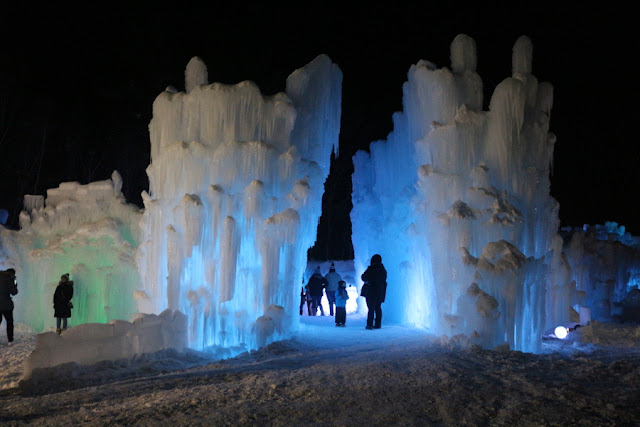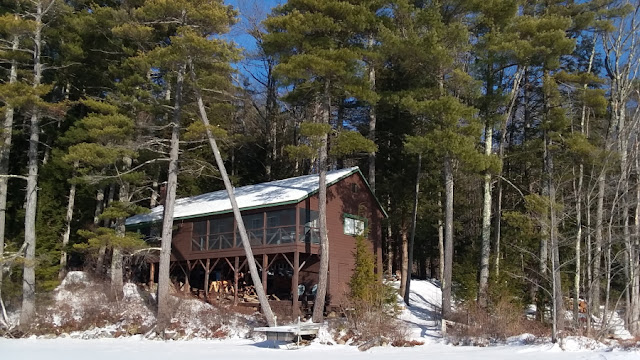 |
| Entrance to the Ice Castles |
We had never been to see them though I'd heard a lot about it - it was worth the trip. They do a lot with lighting and shaping to make them interesting, and there were tunnels and slides to keep the kids entertained.
They even have an ice bar where you can get a warm drink.
 |
| Not many people at the bar on this cold night. |
Before it got dark we took a drive along the Kancamagus Highway, and of course, a trip to Lincoln or Woodstock is always a good excuse for dinner at the Woodstock Inn.
Closer to home I had a couple of nice ski excursions up behind Corliss Hill, over to Lake Winnisquam, and along Old Stage Rd up towards Forest Pond. There's been enough snow to groom the snowmobile trails, and they provided some nice skiing.
 |
| Snowmobile trail over Corliss Hill |
On the lake the strong winds had formed a little wind crust on the snow, creating interesting textures in the process.
 |
| Miniature snow-dunes on the lake. |
Then turning around, and looking in the other direction, I saw another in my series of classic New England houses.
But even with the very cold temperatures (we finally went below zero at -4.7 on Tuesday morning) there was still slush forming at the interface of the snow and the ice on the lakes. This can be trouble when skiing or snowshoeing on the lake.
 |
| When skis meet slush on a cold day. (Always keep a scraper in your pocket!) |
I still don't have a documented explanation for this phenomenon but a fellow skier (thank you HC) suggested it's caused by the weight of the snow pressing on the ice. The theory is the weight makes the ice sink down, forcing water up through holes and small cracks that form in the ice. The concept seems reasonable; I sent a request to NHLakes for more information - they have several articles in their "Extraordinary Winter Lake Phenomena" library, but haven't addressed this one.
In all my excursions this week I didn't see any interesting animals. There were some tracks to be found where the wind hadn't blown them in yet, including this probable set of fox tracks bounding across the lake.
 |
| This fox came off the east shore at a good gallop. |
 |
| And continued on to the west somewhat slower. |
The best I have to report of actual sightings are the animals at the bird feeders. The blue jays have arrived to join the mixed winter flock.
 |
| Blue jays arrived a couple of weeks ago. |
And the gray squirrels are becoming more prevalent at the feeders as the snow pack deepens. Someone (thank you EP!) gave us a cute bird feeder which we re-purposed to a squirrel feeder.
Though there are plenty of birds that spend time in there also, especially the juncos. But it's still more fun to watch the squirrels performing acrobatics on the hanging bird feeder as they collect corn kernels.
I haven't seen any red squirrels at the feeder; it looks like they've been finding enough to eat in the hemlock trees.
 |
| Tiny hemlock cone shells dot the snow where red squirrels pull them apart for the seeds inside. |
Sadly, we had a rain event last night; hopefully another snow storm will come through soon to freshen things up. There will be no new tracks to follow, or skiing to be done, when this saturated snow freezes up. But there will still be reasons to get out, even if it's just to take in the winter sunsets.
 |
| The January sun sets around the northern end of Sheep Island. |









































